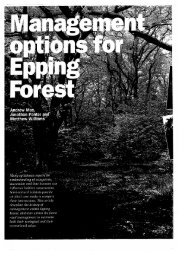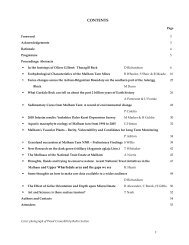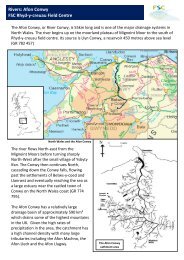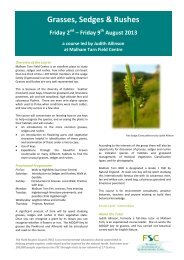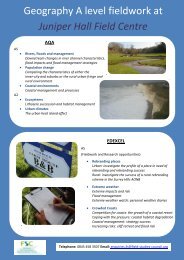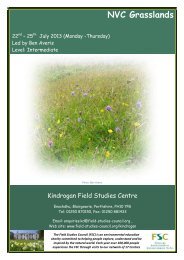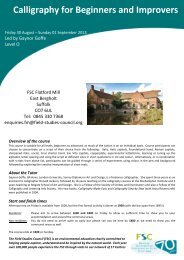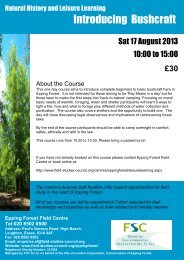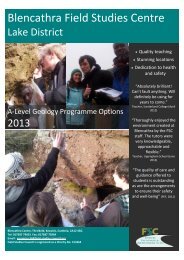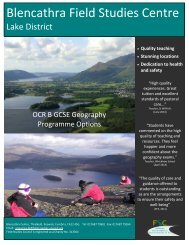A review of research on outdoor learning - Field Studies Council
A review of research on outdoor learning - Field Studies Council
A review of research on outdoor learning - Field Studies Council
- No tags were found...
You also want an ePaper? Increase the reach of your titles
YUMPU automatically turns print PDFs into web optimized ePapers that Google loves.
substantial additi<strong>on</strong>al gains between the end <str<strong>on</strong>g>of</str<strong>on</strong>g> the programand follow-up assessments (Effect Size = 0.17). (p. 43)In other words, ‘it seems that adventure programshave a major impact <strong>on</strong> the lives <str<strong>on</strong>g>of</str<strong>on</strong>g> participants, andthis impact is lasting’ (p. 70).A few years before this, Cas<strong>on</strong> and Gillis (1994)reported similar findings. Through meta-analysis <str<strong>on</strong>g>of</str<strong>on</strong>g>43 studies <str<strong>on</strong>g>of</str<strong>on</strong>g> adolescent adventure programmes, theyfound an average effect size <str<strong>on</strong>g>of</str<strong>on</strong>g> 0.31 (or a 12.2 per centimprovement in the rate <str<strong>on</strong>g>of</str<strong>on</strong>g> <strong>learning</strong> for the averageadolescent).Taken together, these two studies provide str<strong>on</strong>gsupport for the beneficial impact <str<strong>on</strong>g>of</str<strong>on</strong>g> <strong>outdoor</strong>adventure educati<strong>on</strong> programmes <strong>on</strong> young people.This is a point reinforced by others writing in the area:The c<strong>on</strong>sistency <str<strong>on</strong>g>of</str<strong>on</strong>g> these meta-analytic results strengthensthe c<strong>on</strong>clusi<strong>on</strong> that, <strong>on</strong> average, <strong>outdoor</strong> educati<strong>on</strong>programs have a positive impact <strong>on</strong> the self-percepti<strong>on</strong>s <str<strong>on</strong>g>of</str<strong>on</strong>g>participants. (Neill and Richards, 1998, p. 2)In both cases, though, these studies also raisequesti<strong>on</strong>s about the impacts <str<strong>on</strong>g>of</str<strong>on</strong>g> different kinds <str<strong>on</strong>g>of</str<strong>on</strong>g>programmes <strong>on</strong> different kinds <str<strong>on</strong>g>of</str<strong>on</strong>g> outcome measures.To look into this variability, it is necessary to c<strong>on</strong>siderimpacts in the different realms <str<strong>on</strong>g>of</str<strong>on</strong>g> the cognitive, theaffective, the social and the physical.5.2 Cognitive impactsImpacts <strong>on</strong> young people’s knowledge, understandingand cognitive skills is arguably the least str<strong>on</strong>glyevidencedaspect <str<strong>on</strong>g>of</str<strong>on</strong>g> <strong>outdoor</strong> adventure educati<strong>on</strong>. Inmany cases, this simply reflects that fact that ‘[most]adventure programs [do not] have specific aims withrespect to academic goals’ (Hattie et al., 1997, p. 68). A<str<strong>on</strong>g>review</str<strong>on</strong>g> <str<strong>on</strong>g>of</str<strong>on</strong>g> <str<strong>on</strong>g>research</str<strong>on</strong>g> <strong>on</strong> young <str<strong>on</strong>g>of</str<strong>on</strong>g>fenders’ <strong>outdoor</strong>adventure programmes, for example, reports fewstudies that have focused <strong>on</strong>, or found positiveevidence <str<strong>on</strong>g>of</str<strong>on</strong>g>, cognitive impacts (Reddrop, 1997, pp. 10-13). In the school c<strong>on</strong>text, a recent OFSTED survey <str<strong>on</strong>g>of</str<strong>on</strong>g><strong>outdoor</strong> adventure educati<strong>on</strong> in English primary,sec<strong>on</strong>dary and special schools found that ‘structuredassessment and recording <str<strong>on</strong>g>of</str<strong>on</strong>g> <strong>outdoor</strong> andadventurous activities work, and its impact <strong>on</strong> pupils… was rarely found in any type <str<strong>on</strong>g>of</str<strong>on</strong>g> school’ (Clay, 1999,p. 85).However, where <strong>outdoor</strong> adventure programmes dohave aims relating to specific academic skills, it isreported that ‘the effects <strong>on</strong> academic performance aremost impressive’ (Hattie et al., 1997, p. 68). A similarpoint is made in relati<strong>on</strong> to more general academicskills such as problem-solving, whereby ‘it can beclaimed that adventure programs enhance generalproblem-solving competencies’ (ibid., p. 68).A recent example <str<strong>on</strong>g>of</str<strong>on</strong>g> a study focused <strong>on</strong> academicoutcomes is Fox and Avramadis’ (2003) evaluati<strong>on</strong> <str<strong>on</strong>g>of</str<strong>on</strong>g>an <strong>outdoor</strong> educati<strong>on</strong> programme for 13–15 year oldstudents with emoti<strong>on</strong>al and behavioural difficulties(EBD) in south-west England. Based <strong>on</strong> systematicparticipant observati<strong>on</strong> and in-depth interviews withstudents and instructors during two seven-weekcourses (involving <strong>on</strong>e afterno<strong>on</strong> <str<strong>on</strong>g>of</str<strong>on</strong>g> <strong>outdoor</strong> activitiesper week), the <str<strong>on</strong>g>research</str<strong>on</strong>g>ers tracked participants’ (n=14)academic achievement in terms <str<strong>on</strong>g>of</str<strong>on</strong>g> ‘participati<strong>on</strong> in thetask and achievement <str<strong>on</strong>g>of</str<strong>on</strong>g> <strong>learning</strong> objectives’ (ibid., p.273). The findings indicated ‘c<strong>on</strong>siderable variati<strong>on</strong> inthe degree <str<strong>on</strong>g>of</str<strong>on</strong>g> academic success’, but the <str<strong>on</strong>g>research</str<strong>on</strong>g>ers’c<strong>on</strong>clude that while the findings are not clear-cut,‘important academic gains were noted for at least <strong>on</strong>e<str<strong>on</strong>g>of</str<strong>on</strong>g> the participating groups (whilst theunderperformance <str<strong>on</strong>g>of</str<strong>on</strong>g> the other could be attributed topoor attendance)’ (p. 280). This c<strong>on</strong>clusi<strong>on</strong> needs to beseen in the light <str<strong>on</strong>g>of</str<strong>on</strong>g> certain limitati<strong>on</strong>s <str<strong>on</strong>g>of</str<strong>on</strong>g> this studyacknowledged by the authors, most notably the sizeand specificity <str<strong>on</strong>g>of</str<strong>on</strong>g> the sample (11 boys from <strong>on</strong>eindependent residential special school who expressedan interest in <strong>outdoor</strong> educati<strong>on</strong>).Another area <str<strong>on</strong>g>of</str<strong>on</strong>g> cogniti<strong>on</strong> that has been explored bysome studies is the impact <str<strong>on</strong>g>of</str<strong>on</strong>g> <strong>outdoor</strong> adventureeducati<strong>on</strong> <strong>on</strong> young people’s envir<strong>on</strong>mentalknowledge and understanding. In c<strong>on</strong>trast to the<str<strong>on</strong>g>research</str<strong>on</strong>g> <strong>on</strong> fieldwork in Chapter 4, the evidence <str<strong>on</strong>g>of</str<strong>on</strong>g> apositive link between <strong>outdoor</strong> adventure activitiesand envir<strong>on</strong>mental understanding is not str<strong>on</strong>g.Hattie et al. (1997), for example, find limited evidencerelating to envir<strong>on</strong>mental awareness and, where it ismeasured, ‘the effect sizes are very low’ (p. 76).26 >>> A <str<strong>on</strong>g>review</str<strong>on</strong>g> <str<strong>on</strong>g>of</str<strong>on</strong>g> <str<strong>on</strong>g>research</str<strong>on</strong>g> <strong>on</strong> <strong>outdoor</strong> <strong>learning</strong>



